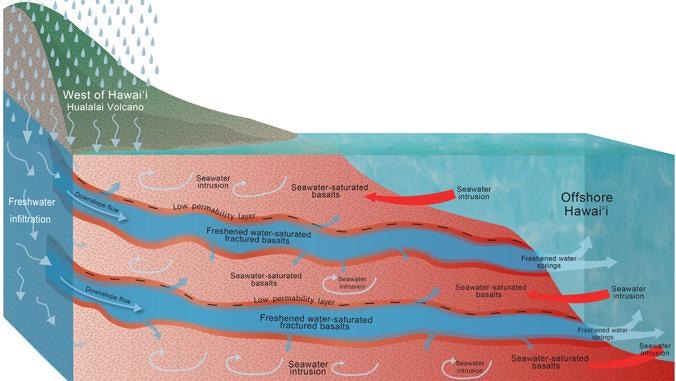Nov 27 2020
A new study by the University of Hawaiʻi (UH) reports that twice as much freshwater is stored offshore of Hawaiʻi Island compared to what was thought earlier. This could have crucial implications for volcanic islands throughout the world.
 Conceptual model of freshwater path from rainfall to offshore. Image Credit: University of Hawaiʻi at Manoa.
Conceptual model of freshwater path from rainfall to offshore. Image Credit: University of Hawaiʻi at Manoa.
As part of the Hawaiʻi EPSCoR ʻIke Wai project, UH researchers have mapped a wide reservoir of freshwater inside the submarine southern flank of the Hualālai aquifer. The unprecedented results were published in the Science Advances journal and unravel a unique way in which considerable volumes of freshwater are transported from onshore to offshore submarine aquifers throughout the coast of Hawaiʻi Island.
This mechanism might offer alternative renewable resources of freshwater to volcanic islands across the globe.
Their evidence for separate freshwater lenses, stacked one above the other, near the Kona coast of Hawaiʻi, profoundly improves the prospects for sustainable development on volcanic islands.
Brian Taylor, Dean, School of Ocean and Earth Science and Technology, University of Hawaiʻi at Manoa
Paradigm Shift
By employing marine controlled-source electromagnetic imaging, the study unraveled the movement of freshwater from onshore-to-offshore via a multilayer formation of basalts sandwiched between layers of ash and soil, varying from earlier groundwater models of this region.
The marine geophysics campaign was carried out as a part of the National Science Foundation-supported ʻIke Wai project and was led by research affiliate faculty Eric Attias.
Our findings provide a paradigm shift from the conventional hydrologic conceptual models that have been vastly used by multiple studies and water organizations in Hawaiʻi and other volcanic islands to calculate sustainable yields and aquifer storage for the past 30 years. We hope that our discovery will enhance future hydrologic models, and consequently, the availability of clean freshwater in volcanic islands.
Eric Attias, University of Hawaiʻi at Manoa
Steven Constable, co-author of the study and geophysics professor at the Scripps Institution of Oceanography, developed the controlled source electromagnetic system utilized for the project.
“I have spent my entire career developing marine electromagnetic methods such as the one used here. It is really gratifying to see the equipment being used for such an impactful and important application. Electrical methods have long been used to study groundwater on land, and so it makes sense to extend the application offshore,” stated Constable.
This new electromagnetic technique is a game changing tool for cost-effective reconnaissance surveys to identify regions containing freshwater aquifers, prior to more expensive drilling efforts to directly sample the pore waters. It can also be used to map the lateral extent of any aquifers already identified in isolated boreholes.
Kerry Key, Associate Professor, Columbia University
Key, who was not part of this study, applies electromagnetic techniques to image several oceanic Earth structures.
Two Times More Water
According to Donald Thomas, a geochemist at the Hawaiʻi Institute of Geophysics and Planetology in SOEST who also contributed to the study, the findings confirm twice the presence of considerably larger quantities of stored groundwater than thought earlier.
“Understanding this new mechanism for groundwater…is important to better manage groundwater resources in Hawaiʻi,” stated Thomas, who heads the Humuʻula Groundwater Research project, which identified another huge freshwater supply on Hawaiʻi Island several years ago.
Offshore freshwater systems analogous to those at the edges of the Hualālai aquifer are proposed to occur for the island of Oʻahu, where the electromagnetic imaging method has not yet been employed. However, if unraveled, it could offer an entirely new concept to regulate freshwater resources.
The study suggests that this newly identified transport mechanism might be the mechanism behind other volcanic islands. Offshore reservoirs are regarded as more resistant to droughts induced by climate change, and thus volcanic islands throughout the world can possibly consider such resources in their water management plans.
This study is financially supported by the National Science Foundation EPSCoR Program Award OIA.
Offshore submarine freshwater discovery raises hopes for islands worldwide
Video Credit: University of Hawaiʻi at Manoa.
Journal Reference:
Attias, E., et al. (2020) Marine electrical imaging reveals novel freshwater transport mechanism in Hawai‘i. Science Advances. doi.org/10.1126/sciadv.abd4866.